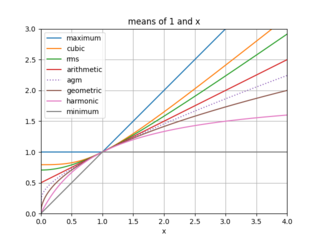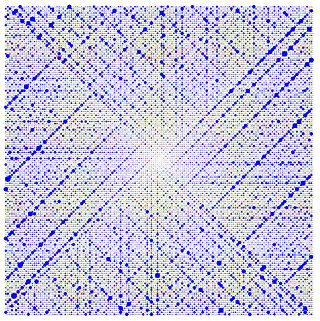
In mathematics, the arithmetic–geometric mean of two positive real numbers x and y is the mutual limit of a sequence of arithmetic means and a sequence of geometric means. The arithmetic–geometric mean is used in fast algorithms for exponential, trigonometric functions, and other special functions, as well as some mathematical constants, in particular, computing π.

In computing, floating-point arithmetic (FP) is arithmetic that represents subsets of real numbers using an integer with a fixed precision, called the significand, scaled by an integer exponent of a fixed base. Numbers of this form are called floating-point numbers. For example, 12.345 is a floating-point number in base ten with five digits of precision:
In number theory, integer factorization is the decomposition of a positive integer into a product of integers. Every positive integer greater than 1 is either the product of two or more integer factors, in which case it is called a composite number, or it is not, in which case it is called a prime number. For example, 15 is a composite number because 15 = 3 · 5, but 7 is a prime number because it cannot be decomposed in this way. If one of the factors is composite, it can in turn be written as a product of smaller factors, for example 60 = 3 · 20 = 3 · (5 · 4). Continuing this process until every factor is prime is called prime factorization; the result is always unique up to the order of the factors by the prime factorization theorem.
In mathematics, a Mersenne prime is a prime number that is one less than a power of two. That is, it is a prime number of the form Mn = 2n − 1 for some integer n. They are named after Marin Mersenne, a French Minim friar, who studied them in the early 17th century. If n is a composite number then so is 2n − 1. Therefore, an equivalent definition of the Mersenne primes is that they are the prime numbers of the form Mp = 2p − 1 for some prime p.

In mathematics, modular arithmetic is a system of arithmetic for integers, where numbers "wrap around" when reaching a certain value, called the modulus. The modern approach to modular arithmetic was developed by Carl Friedrich Gauss in his book Disquisitiones Arithmeticae, published in 1801.

Number theory is a branch of pure mathematics devoted primarily to the study of the integers and arithmetic functions. German mathematician Carl Friedrich Gauss (1777–1855) said, "Mathematics is the queen of the sciences—and number theory is the queen of mathematics." Number theorists study prime numbers as well as the properties of mathematical objects constructed from integers, or defined as generalizations of the integers.

A prime number is a natural number greater than 1 that is not a product of two smaller natural numbers. A natural number greater than 1 that is not prime is called a composite number. For example, 5 is prime because the only ways of writing it as a product, 1 × 5 or 5 × 1, involve 5 itself. However, 4 is composite because it is a product (2 × 2) in which both numbers are smaller than 4. Primes are central in number theory because of the fundamental theorem of arithmetic: every natural number greater than 1 is either a prime itself or can be factorized as a product of primes that is unique up to their order.
In number theory, a prime number p is a Sophie Germain prime if 2p + 1 is also prime. The number 2p + 1 associated with a Sophie Germain prime is called a safe prime. For example, 11 is a Sophie Germain prime and 2 × 11 + 1 = 23 is its associated safe prime. Sophie Germain primes and safe primes have applications in public key cryptography and primality testing. It has been conjectured that there are infinitely many Sophie Germain primes, but this remains unproven.

In mathematics, tables of trigonometric functions are useful in a number of areas. Before the existence of pocket calculators, trigonometric tables were essential for navigation, science and engineering. The calculation of mathematical tables was an important area of study, which led to the development of the first mechanical computing devices.
The Riemann hypothesis is one of the most important conjectures in mathematics. It is a statement about the zeros of the Riemann zeta function. Various geometrical and arithmetical objects can be described by so-called global L-functions, which are formally similar to the Riemann zeta-function. One can then ask the same question about the zeros of these L-functions, yielding various generalizations of the Riemann hypothesis. Many mathematicians believe these generalizations of the Riemann hypothesis to be true. The only cases of these conjectures which have been proven occur in the algebraic function field case.

Prime95, also distributed as the command-line utility mprime for FreeBSD and Linux, is a freeware application written by George Woltman. It is the official client of the Great Internet Mersenne Prime Search (GIMPS), a volunteer computing project dedicated to searching for Mersenne primes. It is also used in overclocking to test for system stability.
Pollard's p − 1 algorithm is a number theoretic integer factorization algorithm, invented by John Pollard in 1974. It is a special-purpose algorithm, meaning that it is only suitable for integers with specific types of factors; it is the simplest example of an algebraic-group factorisation algorithm.
In number theory, a branch of mathematics, the special number field sieve (SNFS) is a special-purpose integer factorization algorithm. The general number field sieve (GNFS) was derived from it.
In finite field theory, a branch of mathematics, a primitive polynomial is the minimal polynomial of a primitive element of the finite field GF(pm). This means that a polynomial F(X) of degree m with coefficients in GF(p) = Z/pZ is a primitive polynomial if it is monic and has a root α in GF(pm) such that is the entire field GF(pm). This implies that α is a primitive (pm − 1)-root of unity in GF(pm).
Eugene Salamin is a mathematician who discovered the Salamin–Brent algorithm, used in high-precision calculation of pi.

Peter Lawrence Montgomery was an American mathematician who worked at the System Development Corporation and Microsoft Research. He is best known for his contributions to computational number theory and mathematical aspects of cryptography, including the Montgomery multiplication method for arithmetic in finite fields, the use of Montgomery curves in applications of elliptic curves to integer factorization and other problems, and the Montgomery ladder, which is used to protect against side-channel attacks in elliptic curve cryptography.

Paul Zimmermann is a French computational mathematician, working at INRIA.
This is a timeline of pure and applied mathematics history. It is divided here into three stages, corresponding to stages in the development of mathematical notation: a "rhetorical" stage in which calculations are described purely by words, a "syncopated" stage in which quantities and common algebraic operations are beginning to be represented by symbolic abbreviations, and finally a "symbolic" stage, in which comprehensive notational systems for formulas are the norm.
43,112,609 is the natural number following 43,112,608 and preceding 43,112,610.











